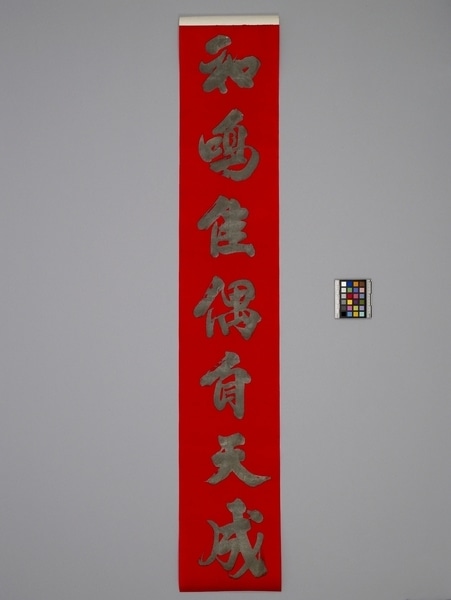Couplet Banner Item Number: 396/1 b from the MOA: University of British Columbia

Description
Piece of red rectangular paper with a vertical column of black ink Chinese characters.
History Of Use
Such couplets were and are used on the occasion of the wedding of a son of the family. The vertical papers are pasted on each side of the main door of the house, where the bride will enter, and the horizontal paper across and above the door. The diamond-shaped paper with the characters meaning “double happiness” is pasted on the door itself, and the red cloth is draped across the top of the door and down both sides.
Iconographic Meaning
The colour red is both auspicious and protective, and the sayings written on the papers have auspicious meanings.
Narrative
Mrs. Yau Chan, Shek-ying gave this set of door decorations used in weddings to Elizabeth Johnson to add to the Chinese collections of the Museum of Anthropology. She understood the importance of preserving objects that provided evidence of the local history that she had experienced, and gave significant support to the collection and documentation of many objects in the Museum of Anthropology’s Hong Kong collections. Hakka people are one of the two original land-dwelling groups that settled the area that became the New Territories of Hong Kong. Their spoken language, and some customs, differed from those of the other original group, the Cantonese or Punti. The Cantonese arrived first and settled on the best rice-growing lands, while the Hakka began to arrive after the late 17th century and settled the more hilly lands.
Item History
- Made in Tsuen Wan, Hong Kong, China during 1976
- Collected by Elizabeth L. Johnson during 1977
- Owned by Chan Shek-Ying Yau
- Owned by Elizabeth L. Johnson before July 14, 1977
- Received from Elizabeth L. Johnson (Donor) on July 14, 1977
What
- Name
- Couplet Banner
- Identification Number
- 396/1 b
- Type of Item
- banner
- Overall
- height 125.0 cm, width 21.0 cm
Who
- Culture
- Chinese: Hakka
- Field Collector
- Elizabeth L. Johnson
- Previous Owner
- Chan Shek-Ying Yau and Elizabeth L. Johnson
- Received from
- Elizabeth L. Johnson (Donor)
Where
- Holding Institution
- MOA: University of British Columbia
- Made in
- Tsuen Wan, Hong Kong, China
When
- Creation Date
- during 1976
- Collection Date
- during 1977
- Ownership Date
- before July 14, 1977
- Acquisition Date
- on July 14, 1977
Other
- Item Classes
- works on paper
- Condition
- good
- Accession Number
- 0396/0001 b